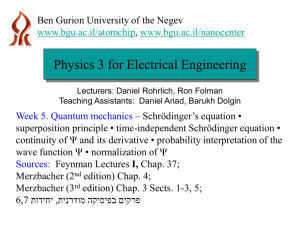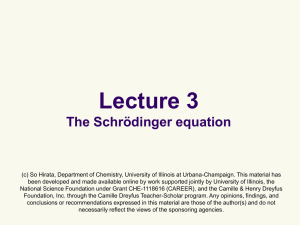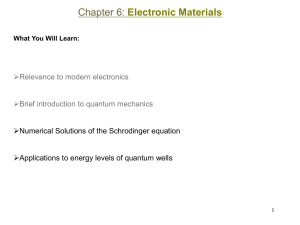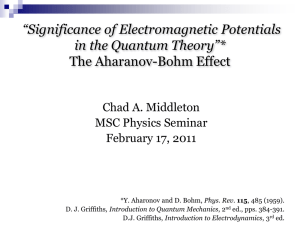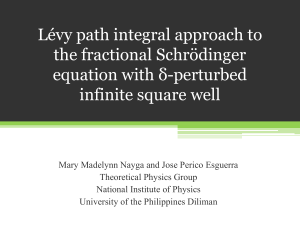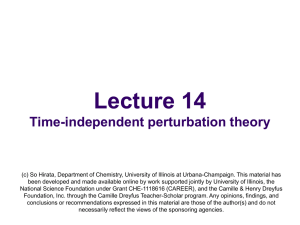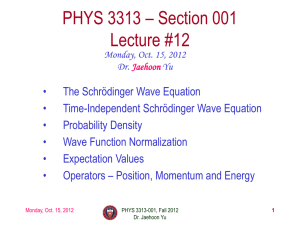Schrödinger`s Equation
advertisement
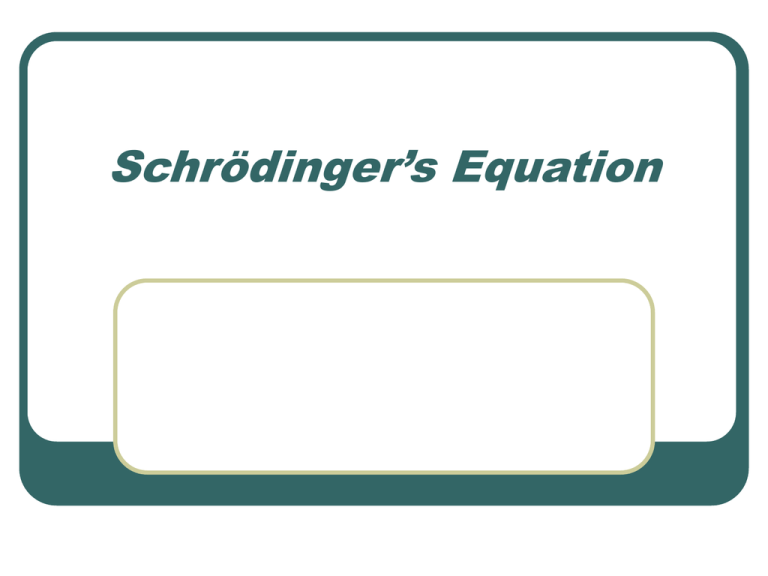
Schrödinger’s Equation Class Objectives How do we get at the information in the wave function? Introduce Schrödinger's equation. Develop the time independent Schrödinger's Equation (TISE). Schrödinger’s Equation The fundamental problem in QM is: Schrödinger’s Equation The fundamental problem in QM is: given the wave function at some instant t=0, find the wave function at a subsequent time. Schrödinger’s Equation The fundamental problem in QM is: given the wave function at some instant t=0, find the wave function at a subsequent time. The wave function (x,0) gives the initial information. Schrödinger’s Equation The fundamental problem in QM is: given the wave function at some instant t=0, find the wave function at a subsequent time. The wave function (x,0) gives the initial information. ( x, t ) is determined from the Schrödinger equation. Schrödinger’s Equation In developing his theory, Schrödinger adopted de Broglie’s equations: h p , vE h As well he defined the total energy E as E p 2m V 2 Schrödinger’s Equation For a particle acted on by a force F, ( x, t ) must be found from Schrödinger's wave equation. Schrödinger’s Equation Schrödinger's wave equation for 1D is written as: 2 2 U ( x) i 2 2m x t Schrödinger’s Equation Schrödinger's wave equation for 1D is written as: 2 2 U ( x) i 2 2m x t U(x) is the potential energy function for the force F. ie. F dU dx Schrödinger’s Equation How do we obtain an equation for ( x, t )? Schrödinger’s Equation How do we obtain an equation for ( x, t )? Schrödinger's equation is a partial differential equation for in terms of two variables. Schrödinger’s Equation How do we obtain an equation for ( x, t )? Schrödinger's equation is a partial differential equation for in terms of two variables. A standard technique is to look for solutions having separable form. Schrödinger’s Equation How do we obtain an equation for ( x, t )? Schrödinger's equation is a partial differential equation for in terms of two variables. A standard technique is to look for solutions having separable form. Ie. ( x, t ) ( x) (t ) Schrödinger’s Equation How do we obtain an equation for ( x, t )? Schrödinger's equation is a partial differential equation for in terms of two variables. A standard technique is to look for solutions having separable form. Ie. ( x, t ) ( x) (t ) Where (x) is a function of x only and (t ) a function of t only. Schrödinger’s Equation Substituting into Schrödinger's equation we get: 2 ( x) (t ) U ( x) ( x) (t ) i ( x) (t ) 2m Schrödinger’s Equation Substituting into Schrödinger's equation we get: 2 ( x) (t ) U ( x) ( x) (t ) i ( x) (t ) 2m Dividing by ( x) (t ) gives 2 ( x) (t ) U ( x) i 2m ( x) (t ) Schrödinger’s Equation LHS is a function of x only. Schrödinger’s Equation LHS is a function of x only. RHS is a function of t only. Schrödinger’s Equation LHS is a function of x only. RHS is a function of t only. Since changing t cannot effect LHS Schrödinger’s Equation LHS is a function of x only. RHS is a function of t only. Since changing t cannot effect LHS (changing x does not affect RHS) Schrödinger’s Equation LHS is a function of x only. RHS is a function of t only. Since changing t cannot effect LHS (changing x does not affect RHS), the differential can be separated into two ODEs. Schrödinger’s Equation Both sides must equal to the same separation constant. Schrödinger’s Equation Both sides must equal to the same separation constant. So that, (t ) 1 d (t ) i i C (t ) (t ) dt ..........S1 2 ( x) U ( x) C 2m ( x) ..........S 2 Schrödinger’s Equation S1 is a 1st order ODE (Φ as a function of t). These have the solution Schrödinger’s Equation S1 is a 1st order ODE (Φ as a function of iCt t). These have the solution (t ) e Schrödinger’s Equation S1 is a 1st order ODE (Φ as a function of iCt t). These have the solution (t ) e NB: You should verify this! Schrödinger’s Equation S1 is a 1st order ODE (Φ as a function of iCt t). These have the solution (t ) e NB: You should verify this! It is easy to show that C = E, the total energy. Schrödinger’s Equation S1 is a 1st order ODE (Φ as a function of iCt t). These have the solution (t ) e NB: You should verify this! It is easy to show that C = E, the total energy. iEt Thus (t ) e Schrödinger’s Equation S1 is a 1st order ODE (Φ as a function of iCt t). These have the solution (t ) e NB: You should verify this! It is easy to show that C = E, the total energy. iEt Thus (t ) e 2 d 2 ( x) And U ( x) ( x) E ( x) 2 2m dx Schrödinger’s Equation 2 d 2 ( x) 2m dx2 U ( x) ( x) E ( x) is the time independent Schrödinger equation. Schrödinger’s Equation 2 d 2 ( x) 2m dx2 U ( x) ( x) E ( x) is the time independent Schrödinger equation. We can write the solution to Schrödinger iEt h equation as ( x, t ) ( x)e Schrödinger’s Equation 2 d 2 ( x) 2m dx2 U ( x) ( x) E ( x) is the time independent Schrödinger equation. We can write the solution to Schrödinger iEt h equation as ( x, t ) ( x)e The expression gives a relationship between the time independent and dependent wave functions. Schrödinger’s Equation 2 d 2 ( x) 2m dx2 U ( x) ( x) E ( x) is the time independent Schrödinger equation. We can write the solution to Schrödinger iEt h equation as ( x, t ) ( x)e The expression gives a relationship between the time independent and dependent wave functions. The solutions for (x) are that of planes. ie ( x) e ikx Schrödinger’s Equation The functions of (x) are called eigenfunctions. Schrödinger’s Equation The functions of (x) are called eigenfunctions. Solutions of Schrödinger’s equation are stationary states. Schrödinger’s Equation The functions of (x) are called eigenfunctions. Solutions of Schrödinger’s equation are stationary states. This because they are time independent and the probability distributions are time independent. Schrödinger’s Equation The functions of (x) are called eigenfunctions. Solutions of Schrödinger’s equation are stationary states. This because they are time independent and the probability distributions are time independent. ( x, t ) ( x ) 2 Schrödinger’s Equation Because the probabilities are static they can be calculated from the time independent wave form.

